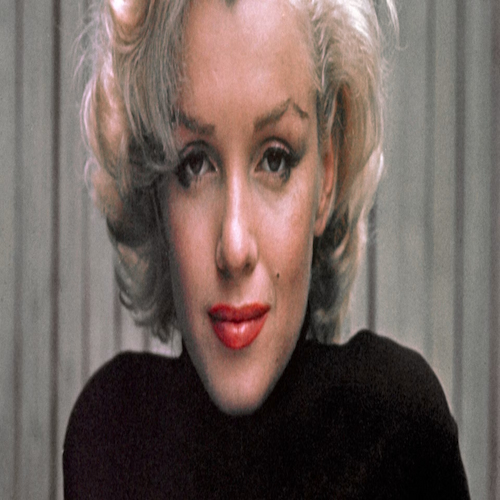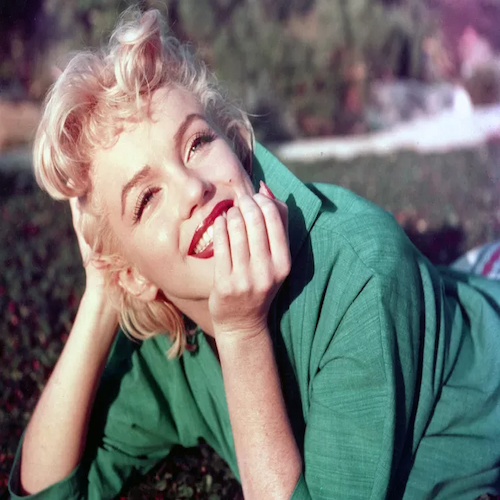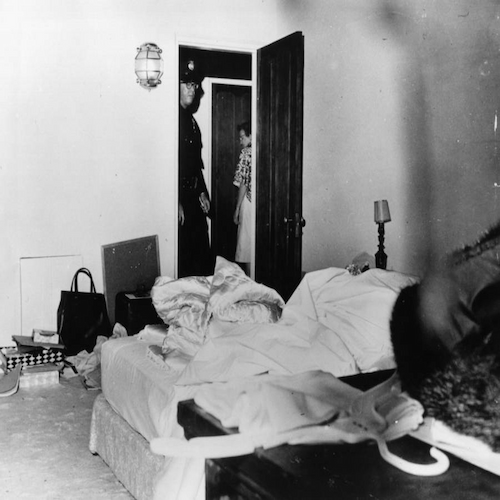The Mystery Around The Death Of Marilyn Monroe, Ghostly Hauntings and a UFO Conspiracy

Few figures in American pop culture shimmer with such timeless allure—or such haunting mystery—as Marilyn Monroe. With her cascade of platinum hair, the glow of a star who seemed made of starlight itself, and performances that turned cinema into silk and flame in Some Like It Hot and Gentlemen Prefer Blondes, she was Hollywood’s golden dream made flesh.
Yet behind the radiance lurked shadows. Her death at thirty-six became the echo that would not fade, a riddle wrapped in velvet whispers. “It wasn’t an overdose,” some insist. “It was a silenced truth.” Others swear, “The government knew more than they ever confessed.” And still, in the dark corners of Los Angeles, voices murmur, “She walks here still,” drifting through hotel corridors and studio lots, forever caught between reel and reality.
Then come the strangest murmurs of all—the dreamers who look skyward and claim, “She knew secrets not of this world.” So Marilyn remains: not merely a woman or a star, but a constellation of mystery, glowing softly at the edge of belief, where tragedy, superstition, and stardust entwine.
The Death of Marilyn Monroe, Official Story
On the night of August 5, 1962, silence settled over Marilyn Monroe’s Brentwood home. A silence that would soon echo around the world. By morning, she was gone. The official report spoke plainly, almost coldly: “acute barbiturate poisoning”—a probable suicide. By her bedside lay the empty pill bottles, the sterile evidence of despair. And yes, her battles were known—depression, anxiety, sleepless nights that no fame could soothe.
But almost before the ink had dried on the coroner’s report, the questions began to whisper. “She wasn’t ready to die,” her friends insisted. “She was planning new films, talking about the future.” Others swore the scene didn’t make sense—the bedroom light that was on or off, the confusion over who found her first, the strange suggestion that things had been moved before the police arrived.
The coroner’s office settled uneasily on “probable suicide,” but even that phrasing—so careful, so uncertain—left a crack in the door. And through that narrow opening poured decades of doubt, rumor, and speculation. For some, her death was simply too tidy, too scripted—an ending written not by tragedy, but by someone else’s hand.
The Kennedy Connection
Perhaps the most infamous of all the tales surrounding Marilyn Monroe’s death is the one that binds her name to two of the most powerful men in America—President John F. Kennedy and Attorney General Robert F. Kennedy.
According to the chorus of biographers, confidants, and Hollywood insiders, Monroe had wandered into a dangerous constellation of desire and influence, where love and politics intertwined like smoke and silk. They whispered that she had gathered secrets not meant for the ears of starlit women—secrets murmured between champagne and candlelight, heavy with consequence and power. Some believed she had grown restless beneath their weight, that she intended to step from the shadows and let truth gleam in daylight, no matter the cost.
READ ALSO: The Superman Curse: The Dark Tragedies Behind the Man of Steel
Such whispers became the tinder for darker imaginings—that her death was no act of despair, but an erasure, deliberate and precise. To those who believed, the tragedy no longer looked like a lonely night in Brentwood, but like a stage carefully set, the final scene of a story too perilous to tell aloud.
UFO Conspiracies
The strangest turn in the labyrinth of Marilyn Monroe’s legend drifts not from Hollywood, but from the shadowed corridors of classified history. It comes in whispers of Majestic 12. The secretive, perhaps mythical committee said to have probed the skies in search of truths too vast for daylight, back in the 1940s and ’50s.
Decades later, in the restless glow of the 1990s, UFO researchers began passing among themselves a curious relic: a document they called the “Marilyn Monroe UFO Memo.” Said to be a CIA transcript, it spoke of phone calls that hinted Monroe had come too close to the forbidden. Knowledge of a government veil drawn tightly over wreckage and visitors from beyond, possibly the same desert ghosts once called Roswell.
The theory unfurled like a fever dream. Monroe, it claimed, had been told of these celestial secrets during her entanglement with President Kennedy. The memo suggested she had grown impatient with silence, that she intended to summon the press and unveil not only the truth of her love affairs but of humanity’s contact with other worlds.
Skeptics would later dissect the document, finding its flaws in margins and typefaces, its origin untraceable, its authority unprovable. Yet for those who believe, the idea remained intoxicating. That Marilyn’s final secret was not of politics or passion, but of stars and silence. In their telling, her death became more than a tragedy; it became an interstellar secret folded into the heart of a Hollywood myth.
Marilyn Monroe, Diary Of Secrets
According to Nick Redfern, Marilyn Monroe once guarded a small but dangerous treasure—what she called her “diary of secrets.” It began innocently enough, a gift of introspection encouraged by her husband, Joe DiMaggio. In its early pages, she scrawled fragments of her days—film sets, fleeting faces, the glittering machinery of Hollywood. But as time passed, the diary deepened, darkened, became something else entirely.
Redfern tells that Monroe began to record not just the rhythms of her life, but the murmurs she overheard in powerful company: the Kennedy brothers’ talk of Castro’s impending assassination, CIA entanglements with the Mafia, and other confidences not meant for a starlet’s pages.
The diary, thick with danger and curiosity, became a quiet archive of forbidden conversations.
When her body was delivered to the morgue, Redfern writes, the diary was still among her effects—a silent witness resting beside her. For a few days, it lingered there, unremarked upon, until, according to those who claimed to see it, a group of men in dark suits arrived. They took the diary and left no trace. From that moment, it was as though it had never existed.
That disappearance breathed oxygen into the fire of speculation. Some believed the diary had been seized to shield national secrets, to erase evidence of Monroe’s proximity to knowledge too dangerous for daylight. Redfern’s book threads this mystery into even wider conspiracies—that the diary held references not only to espionage and politics, but to UFOs, alien bodies, and classified truths whispered by a president.
In this telling, Monroe’s fate was no accident of despair. It became the tragic closing act of a woman who had learned too much—her light extinguished not by sorrow, but by the weight of secrets too large for one heart to hold.
The Death of Marilyn Monroe, Where Her Ghost Is Sighted
Though it remains to be known whether her death was suicide, murder, or something far stranger, Marilyn Monroe has never truly left Los Angeles. Her name lingers like perfume on warm air, her memory flickering in the corners of the city she once adored. Over the decades, countless tales have risen—whispers of her ghostly presence, drifting through Hollywood’s night like a dream that refuses to fade.
1. The Roosevelt Hotel – Hollywood
In the heart of Hollywood, the Roosevelt Hotel glows with old glamour, its walls breathing the stories of stars long gone. Here, Monroe once laughed, posed, and dreamed in her early years, and here—so many say—she still remains. Guests have claimed her reflection shimmers in a full-length mirror once kept in her favorite suite, now set like a relic in the hotel lobby. Some speak of a sudden chill brushing their skin, a faint trace of Chanel No. 5 on empty air, or the sensation of unseen eyes watching from the gilded corners. The hotel hums softly with her presence, as if she checks in every night but never quite leaves.
2. Her Brentwood Home

At 12305 Fifth Helena Drive, the house where Monroe’s story ended has become both shrine and shadow. Visitors tell of entering rooms heavy with sorrow, where whispers seem to rise from the walls and footsteps echo down hallways empty of life. Some have glimpsed a pale figure moving through the dimness—a woman luminous and lost, forever walking toward a peace she never found.
3. Westwood Village Memorial Park Cemetery
Beneath the soft lawns of Westwood Village Memorial Park, Monroe rests—or tries to. Her crypt, kissed by lipstick and flowers from pilgrims of every age, draws those who still seek her. Mourners have spoken of soft sobs in the night air, faint flashes of light that dance near her niche, or the brush of invisible movement beside them. Around her lie other Hollywood spirits—Dean Martin, Natalie Wood, and more—as if the cemetery itself hums with the electric residue of stardom, a quiet afterglow that refuses to fade.
4. Other Reports
Beyond these known places, her spirit is said to wander still. Psychics and night-watchers claim she drifts through soundstages and backlots, the eternal actress rehearsing scenes no one will ever see. ome claim that the camera’s lens draws her, and that she flickers unexpectedly on film—a spectral cameo from the world beyond.
Whether these tales are longing made visible or something truly supernatural, Marilyn Monroe’s ghost endures like her legend: radiant, sorrowful, and forever searching for the light.
The Death of Marilyn Monroe: Why it Still Haunts Hollywood

What makes Marilyn Monroe’s death—and her ghost—so endlessly captivating is the way she embodies every contradiction of the human heart. She embodied both the dream and the dreamer, the adored and the abandoned, a shimmering star whose own loneliness fueled her light. Her story is a collision of opposites: public glamour and private despair, innocence and seduction, fame and exploitation. Hollywood sculpted her with fantasy, yet its weight undone her, and perhaps that is why her afterlife feels less like a haunting and more like a continuation. An echo of unfinished longing that refuses to dim.
The UFO connection drapes her myth in stranger fabrics still, turning her from a symbol of earthly desire into a tragic figure orbiting the secrets of the cosmos. Whether or not the “Marilyn UFO Memo” was ever real, it reveals something deeply human: our hunger to believe that she knew more, saw more, was more than the world allowed her to be.
In the end, Monroe remains suspended between heaven and earth—an icon whose mystery mirrors our own yearning for meaning in the unknown. Her story, like a distant star, continues to glow long after the flame itself has gone out.
The Death of Marilyn Monroe, The Unanswered Questions
More than sixty years after her passing, Marilyn Monroe remains both a symbol and a question mark—a luminous mystery flickering at the edge of America’s collective imagination. Had fame and pharmaceuticals slowly worn her soul thin, or did those who feared what she might reveal deliberately silence her? Did she truly glimpse the hidden machinery of power, brush against the secrets of UFOs and cosmic cover-ups, or is that notion simply our way of keeping her story alive—by turning tragedy into legend, and legend into myth?
And then there are the ghostly encounters—the whispers in old hotels, the scent of perfume in empty rooms, the soft echo of footsteps that never fade. Are these the lingering traces of a restless spirit still seeking peace, or merely the echoes of our own fascination, projected onto the shimmer of a life too brief and too bright?
Her presence endures not only in film reels and photographs but on the very streets she once walked. Join us on the Hollywood Boulevard Ghost Walk, departing nightly at 7 p.m. from the Dolby Theatre—a journey through the glamour, the grief, and the golden haze of old Hollywood. Step into the Dream Factory, where fact and fantasy intertwine, and where Marilyn’s story still glows in the shadows—forever beautiful, forever unfinished.



